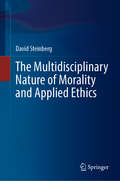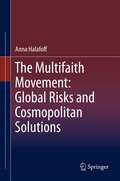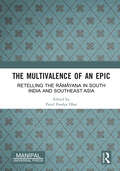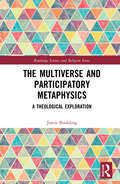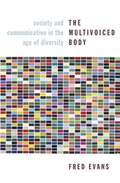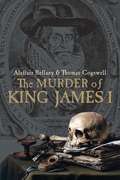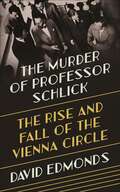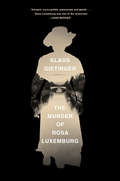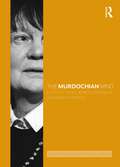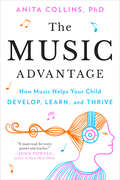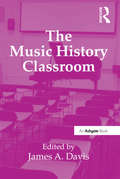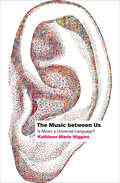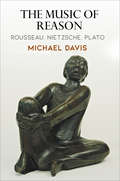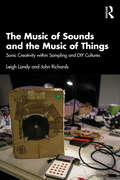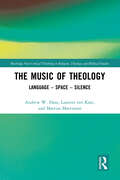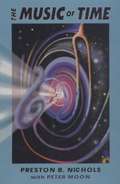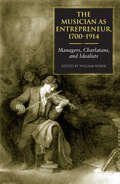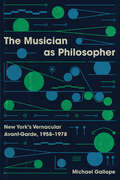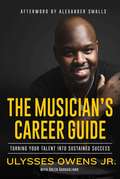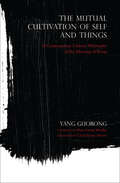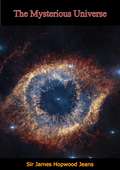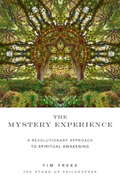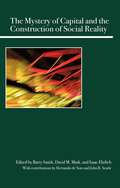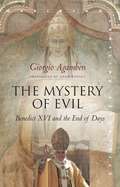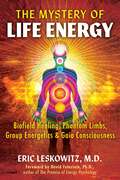- Table View
- List View
The Multidisciplinary Nature of Morality and Applied Ethics
by David SteinbergMost people intuitively understand the nature of morality; this tends to belie the fact that morality is more complex, controversial and interesting than generally appreciated. This book provides a comprehensive overview of morality from various disciplines and perspectives. These include ethics and evolution, moral psychology, morality and culture, morality and religion and morality and the law. A chapter on evil illustrates the vulnerability of morality. The book also provides a description and critique of various ethical theories, the difference between a moral obligation and a moral ideal and the views of venerable moral philosophers who argue over issues such as whether objective moral truth exists. A number of practical ethical dilemmas are discussed. The book is written in language accessible to the general reader and will be of interest to members of organizational, governmental, and professional ethics committees, students in ethics fellowships or ethics degree programs, philosophers, and others who want to learn more about morality.
The Multifaith Movement: Global Risks and Cosmopolitan Solutions
by Anna HalafoffThis book documents the ultramodern rise of the multifaith movement, as mulitfaith initiatives have been increasingly deployed as cosmopolitan solutions to counter global risks such as terrorism and climate change at the turn of the 21st century. These projects aim to enhance common security, particularly in Western societies following the events of September 11, 2001 and the July 2005 London bombings, where multifaith engagement has been promoted as a strategy to counter violent extremism. The author draws on interviews with 56 leading figures in the field of multifaith relations, including Paul Knitter, Eboo Patel, Marcus Braybrooke, Katherine Marshall, John Voll and Krista Tippett. Identifying the principle aims of the multifaith movement, the analysis explores the benefits--and challenges--of multifaith engagement, as well as the effectiveness of multifaith initiatives in countering the process of radicalization. Building on notions of cosmopolitanism, the work proposes a new theoretical framework termed 'Netpeace', which recognizes the interconnectedness of global problems and their solutions. In doing so, it acknowledges the capacity of multi-actor peacebuilding networks, including religious and state actors, to address the pressing dilemmas of our times. The primary intention of the book is to assist in the formation of new models of activism and governance, founded on a 'politics of understanding' modeled by the multifaith movement.
The Multivalence of an Epic: Retelling the Rāmāyaṇa in South India and Southeast Asia
by Parul Pandya DharThis volume examines The Rāmāyaṇa traditions of South India and Southeast Asia. Bringing together 19 well-known scholars in Rāmāyaṇa studies from Cambodia, Canada, France, India, Indonesia, Malaysia, Singapore, Thailand, UK, and USA, this thought-provoking and elegantly illustrated volume engages with the inherent plurality, diversity, and adaptability of the Rāmāyaṇa in changing socio-political, religious, and cultural contexts. The journey and localization of the Rāmāyaṇa is explored in its manifold expressions – from classical to folk, from temples and palaces to theatres and by-lanes in cities and villages, and from ancient to modern times. Regional Rāmāyaṇas from different parts of South India and Southeast Asia are placed in deliberate juxtaposition to enable a historically informed discussion of their connected pasts across land and seas. The three parts of this volume, organized as visual, literary, and performance cultures, discuss the sculpted, painted, inscribed, written, recited, and performed Rāmāyaṇas. A related emphasis is on the way boundaries of medium and genre have been crossed in the visual, literary, and performed representations of the Rāmāyaṇa. Print edition not for sale in South Asia (India, Sri Lanka, Nepal, Bangladesh, Pakistan and Bhutan)
The Multiverse and Participatory Metaphysics: A Theological Exploration (Routledge Science and Religion Series)
by Jamie BouldingThis book offers a new theological approach to the multiverse hypothesis. With a distinctive methodology, it shows that participatory metaphysics from ancient and medieval sources represents a fertile theological ground on which to grapple with contemporary ideas of the multiverse. There are three key thinkers and themes discussed in the book: Plato and cosmic multiplicity, Aquinas and cosmic diversity, and Nicholas of Cusa and cosmic infinity. Their insights are brought into interaction with a diverse range of contemporary theological, philosophical, and scientific figures to demonstrate that a participatory account of the relationship between God and creation leads to a greater continuity between theology and the multiverse proposal in modern cosmology. This is in contrast to existing work on the subject, which often assumes that the two are in conflict. By offering a fresh way to engage theologically with multiverse theory, this book will be a unique resource for any scholar of Religion and Science, Theology, Metaphysics, and Cosmology.
The Multivoiced Body: Society and Communication in the Age of Diversity
by Fred EvansEthnic cleansing and other methods of political and social exclusion continue to thrive in our globalized world, complicating the idea that unity and diversity can exist in the same society. When we emphasize unity, we sacrifice heterogeneity, yet when we stress diversity, we create a plurality of individuals connected only by tenuous circumstance. As long as we remain tethered to these binaries, as long as we are unable to imagine the sort of society we want in an age of diversity, we cannot achieve an enduring solution to conflicts that continue unabated despite our increasing proximity to one another.By envisioning the public as a multivoiced body, Fred Evans offers a solution to the dilemma of diversity. The multivoiced body is both one and many: heterogeneous voices that at once separate and bind themselves together through their continuous and creative interplay. By focusing on this traditionally undervalued or overlooked notion of voice, Evans shows how we can valorize simultaneously the solidarity, diversity, and richness of society. Moreover, recognition of society as a multivoiced body helps resists the pervasive countertendency to raise a chosen discourse to the level of "one true God," "pure race," or some other "oracle" that eliminates the dynamism of contesting voices.To support these views, Evans taps the major figures and themes of analytic and continental philosophy as well as modernist, postmodernist, postcolonial, and feminist thought. He also turns to sources outside of philosophy to address the implications of his views for justice, citizenship, democracy, and collective as well as individual rights. Through the seemingly simple conceit of a multivoiced body, Evans straddles both philosophy and political practice, confronting issues of subjectivity, language, communication, and identity. For anyone interested in moving toward a just society and politics, The Multivoiced Body offers an innovative approach to the problems of human diversity and ethical plurality.
The Murder of King James I
by Alastair Bellany Thomas CogswellA year after the death of James I in 1625, a sensational pamphlet accused the Duke of Buckingham of murdering the king. It was an allegation that would haunt English politics for nearly forty years. In this exhaustively researched new book, two leading scholars of the era, Alastair Bellany and Thomas Cogswell, uncover the untold story of how a secret history of courtly poisoning shaped and reflected the political conflicts that would eventually plunge the British Isles into civil war and revolution. Illuminating many hitherto obscure aspects of early modern political culture, this eagerly anticipated work is both a fascinating story of political intrigue and a major exploration of the forces that destroyed the Stuart monarchy.
The Murder of Professor Schlick: The Rise and Fall of the Vienna Circle
by David EdmondsFrom the author of Wittgenstein's Poker and Would You Kill the Fat Man?, the story of an extraordinary group of philosophers during a dark chapter in Europe's historyOn June 22, 1936, the philosopher Moritz Schlick was on his way to deliver a lecture at the University of Vienna when Johann Nelböck, a deranged former student of Schlick's, shot him dead on the university steps. Some Austrian newspapers defended the madman, while Nelböck himself argued in court that his onetime teacher had promoted a treacherous Jewish philosophy. David Edmonds traces the rise and fall of the Vienna Circle—an influential group of brilliant thinkers led by Schlick—and of a philosophical movement that sought to do away with metaphysics and pseudoscience in a city darkened by fascism, anti-Semitism, and unreason.The Vienna Circle's members included Otto Neurath, Rudolf Carnap, and the eccentric logician Kurt Gödel. On its fringes were two other philosophical titans of the twentieth century, Ludwig Wittgenstein and Karl Popper. The Circle championed the philosophy of logical empiricism, which held that only two types of propositions have cognitive meaning, those that can be verified through experience and those that are analytically true. For a time, it was the most fashionable movement in philosophy. Yet by the outbreak of World War II, Schlick's group had disbanded and almost all its members had fled. Edmonds reveals why the Austro-fascists and the Nazis saw their philosophy as such a threat.The Murder of Professor Schlick paints an unforgettable portrait of the Vienna Circle and its members while weaving an enthralling narrative set against the backdrop of economic catastrophe and rising extremism in Hitler's Europe.
The Murder of Rosa Luxemburg
by Klaus GietingerOn the tracks of the killers of Rosa LuxemburgThe cold-blooded murder of revolutionary icons Rosa Luxemburg and Karl Liebknecht in the pitched political battles of post-WWI Germany marks one of the greatest tragedies of the 20th century. No other political assassination inflamed popular passions and transformed Germany's political climate as that killing in the night of 15-16 January 1919 in front of the luxurious Hotel Eden. It not only cut short the lives of two of the country's most brilliant political leaders, but also inaugurated a series of further political assassinations designed to snuff out the revolutionary flame and, ultimately, pave the way for the ultra-reactionary forces that would take power in 1933. To commemorate the 100th anniversary of their untimely deaths, Klaus Gietinger has carefully reconstructed the events on that fateful night, digging deep into the archives to identify who exactly was responsible for the murder, and what forces in high-placed positions had a hand in facilitating it and protecting the culprits.
The Murdochian Mind (Routledge Philosophical Minds)
by Silvia Caprioglio PanizzaIris Murdoch was a philosopher and novelist of extraordinary breadth and originality whose work defies simple categorisation. Her philosophical writing engages with an astonishingly wide range of figures, from Plato and Kant to Sartre and Heidegger, and her work increasingly inspires debate in ethics, aesthetics, religion, and literature. The Murdochian Mind is an outstanding reference source to the full span of Murdoch's philosophical work, comprising 37 specially commissioned chapters written by an international team of leading scholars. Divided into five clear parts, the volume covers the following areas: A guide to Murdoch's key philosophical texts, including The Sovereignty of Good and Metaphysics as a Guide to Morals. Core themes and concepts in Murdoch's philosophy, such as love, moral vision, and attention. Murdoch's engagement with the history of philosophy, including Plato, Kant, Hegel, Simone Weil, and Wittgenstein. Interdisciplinary connections with art, literature, and religion, including Judaism, Buddhism, and Christianity. Murdoch and contemporary philosophical debates, including feminism, virtue ethics, and metaethics. The application of Murdoch’s thought to applied ethics, including animal ethics, psychiatric ethics, and the environment. Although recent years have seen a blossoming of interest in Murdoch’s philosophy, The Murdochian Mind is the first volume to do justice to the incredibly rich and wide-ranging nature of her work. As such it will be of great interest to students of philosophy, especially ethics and aesthetics, as well as those in related disciplines such as literature, religion, and gender studies.
The Music Advantage: How Music Helps Your Child Develop, Learn, and Thrive
by Dr. Anita CollinsAn expert in cognitive development and music education reveals the remarkable and surprising benefits that playing--or even appreciating--music offers to children.The latest cognitive research has revealed something extraordinary: learning music and listening to music can grow and repair our brains at any age. Here, Dr. Anita Collins explains how music has the potential to positively benefit almost all aspects of a child's development, whether it's through formal education or mindful appreciation; simply clapping in time can assist a young child who is struggling with reading. It turns out that playing music is the cognitive equivalent of a full-body workout. Dr. Collins lays out the groundbreaking research that shows how playing an instrument can improve language abilities, social skills, concentration, impulse control, emotional development, working memory, and planning and strategy competence, from infancy through adolescence. She also provides real-life stories to show the difference that music learning can make, as well as practical strategies for parents and educators to encourage a love of music in their kids.
The Music History Classroom
by James A. DavisThe Music History Classroom brings together essays written by recognized and experienced teachers to assist in the design, implementation, and revision of college-level music history courses. This includes the traditional music history survey for music majors, but the materials presented here are applicable to other music history courses for music majors and general education students alike, including period classes, composer or repertory courses, and special topics classes and seminars. The authors bring current thought on the scholarship of teaching and learning together with practical experience into the unique environment of the music history classroom. While many of the issues confronting teachers in other disciplines are pertinent to music history classes, this collection addresses the unique nature of musical materials and the challenges involved in negotiating between historical information, complex technical musical issues, and the aesthetics of performing and listening. This single volume provides a systematic outline of practical teaching advice on all facets of music history pedagogy, including course design, classroom technology, listening and writing assignments, and more. The Music History Classroom presents the 'nuts-and-bolts' of teaching music history suitable for graduate students, junior faculty, and seasoned teachers alike.
The Music between Us: Is Music a Universal Language?
by Kathleen Marie Higgins&“Higgins&’ love of music and cultural variety is evident throughout. She writes in a relaxed, accessible, sophisticated style…Highly recommended.&”—Choice From our first social bonding as infants to the funeral rites that mark our passing, music plays an important role in our lives, bringing us closer to one another. In this book, philosopher Kathleen Marie Higgins investigates this role, examining the features of human perception that enable music&’s uncanny ability to provoke—despite its myriad forms across continents and throughout centuries—the sense of a shared human experience. Drawing on disciplines such as philosophy, psychology, musicology, linguistics, and anthropology, Higgins&’s richly researched study showcases the ways music is used in rituals, education, work, and healing, and as a source of security and—perhaps most importantly—joy. By participating so integrally in such meaningful facets of society, Higgins argues, music situates itself as one of the most fundamental bridges between people, a truly cross-cultural form of communication that can create solidarity across political divides. Moving beyond the well-worn takes on music&’s universality, The Music between Us provides a new understanding of what it means to be musical and, in turn, human. &“Those who, like Higgins, deeply love music, actually know something about it, have open minds and ears, and are willing to look beyond the confines of Western aesthetics…will find much to learn in The Music between Us.&”—Journalof Aesthetics and Art Criticism
The Music of Reason: Rousseau, Nietzsche, Plato (Haney Foundation Series)
by Michael DavisIn recent years, the field of cognitive psychology has begun to explore the rootedness of rational thinking in subrational inspiration, insight, or instinct—a kind of prediscursive hunch that leaps ahead and guides rational thought before the reasoning human being is even aware of it. In The Music of Reason, Michael Davis shows that this "musical" quality of thinking is something that leading philosophers have long been aware of and explored with great depth and subtlety. Focusing on the work of three thinkers traditionally viewed as among the most poetic of philosophers—Rousseau, Nietzsche, and Plato—Davis reveals the complex and profound ways in which they each plumbed the depths of reason's "prerational" foundations.Davis first examines Rousseau's Essay on the Origins of Languages: Where Something Is Said About Melody and Musical Imitation and Nietzsche's The Birth of Tragedy Out of the Spirit of Music to demonstrate that revealing the truth, or achieving individual enlightenment, requires poetic techniques such as irony, indirection, and ambiguity. How philosophers say things is as worthy of our attention as what they say. Turning to Plato's Lesser Hippias, Davis then reconsiders the relation between truth-telling and lying, finding the Platonic dialogue to be an artful synthesis of music and reason.The "ancient quarrel between philosophy and poetry" that Plato placed near the core of this thinking suggests a tension between the rational (scientific) and the nonrational (poetic), or between the true and the beautiful—the one clear and definite, the other allusive and musical. Contemplating language in Rousseau, the Dionysian in Nietzsche, and playfulness in Plato, The Music of Reason explores how what we might initially perceive as irrational and so antithetical to reason is, in fact, constitutive of it.
The Music of Sounds and the Music of Things: Sonic Creativity Within Sampling and DIY Cultures
by Leigh Landy John RichardsThis book investigates two areas in which the appreciation of sonic creativity can be easily acquired across diverse cultures, ages and interests: the music of sounds – making music with any sounds, part of today’s sampling culture and the music of things – and the creation of instruments using existent materials (another type of sampling?) involving the notion of ‘instrument as composition’ as part of today’s DIY (or DIT, do it together) culture.The book offers broad discussions regarding the music of things (written by John Richards) followed by the music of sounds (written by Leigh Landy). These chapters are followed by a focus on the workshop demonstrating the collaborative and inclusive potential in both areas, and a spotlight on eight artists with a broad diversity of backgrounds and approaches to sound and music who discuss their perceptions. The book’s conclusion focuses on similarities and differences between the music of sounds and the music of things, suggesting, finally, that both might form part of the 21st- century’s folk music landscape.The book is primarily aimed towards students interested in current forms of sonic creativity but will be of interest to those interested in broader issues of sampling culture, hacking and sound studies.
The Music of Theology: Language – Space – Silence (Routledge New Critical Thinking in Religion, Theology and Biblical Studies)
by Andrew Hass Mattias Martinson Laurens ten KateThis book reconceives theology as a musical endeavour in critical tension with language, space and silence. An Overture first moves us from music to religion, and then from theology back to music – a circularity that, drawing upon history, sociology, phenomenology, and philosophy, disclaims any theology of music and instead pursues the music in theology. The chapters that follow explore the three central themes by way of theory, music and myth: Adorno, Benjamin and Deleuze (language), Derrida, Rosa and Nancy (space), Schelling/Hegel, Homer and Cage (silence). In overdubbing each other, these chapters work towards theology as a sonorous rhythm between loss and freedom. A Coda provides three brief musical examples – Thomas Tallis, György Ligeti, and Evan Parker – as manifestations of this rhythm, to show in summary how music becomes the very pulse of theology, and theology the very intuition of music. The authors offer an interdisciplinary engagement addressing fundamental questions of the self and the other, of humanity and the divine, in a deconstruction of modern culture and of its bias towards the eye over the ear. The book harmonizes three scholarly voices who attempt to find where the resonance of our Western conceptions and practice, musically and theologically, might resound anew as a more expansive music of theology.
The Music of Time
by Preston B. NicholsFor the first time, Preston reveals his employment at Brookhaven Labs and how his connections in the music industry were used for mind control and manipulation of the masses. Ultimately, Preston's real-life adventures lead to time travel, his own role in the future, and the efforts of his adversaries to arrest him and put him permanently out of commission. This includes the bone chilling story of John Ford, Preston's colleague, who is locked up without a trial for his own efforts to expose the truth. In a remarkable twist of fate, mysterious forces rescue Preston and begin a documented investigation and eventual conviction of the most politically powerful man on Long Island. This book reveals more layers of mystery in mankind's epic quest to understand the paradox of time and the imprisonment of consciousness.
The Musician as Entrepreneur, 1700–1914: Managers, Charlatans, and Idealists
by William Weber“Marries scholarly discipline with intriguing reading . . . The book will satisfy the thirst of historians, musicians and perhaps even an economist or two.” —American Music TeacherTo be successful, a musician often has to be an entrepreneur: someone who starts a performing venue, develops patrons, and promotes the project aggressively. Accomplishing this requires musicians to acquire social and business skills and to be highly opportunistic in what they do. In The Musician as Entrepreneur, 1700–1914, international scholars investigate cases of musical entrepreneurship between around 1700 and 1914 in Britain, France, Germany, and the United States. By uncovering the ways in which musicians such as Telemann, Beethoven, Paganini, and Liszt conducted their daily business, the authors reveal how musicians reshaped the frameworks of musical culture and, in the process, the nature of the music itself.“Weber is an excellent music historian and the book will please all readers interested in musical sociology.” —Choice
The Musician as Philosopher: New York’s Vernacular Avant-Garde, 1958–1978
by Michael GallopeAn insightful look at how avant-garde musicians of the postwar period in New York explored the philosophical dimensions of music’s ineffability. The Musician as Philosopher explores the philosophical thought of avant-garde musicians in postwar New York: David Tudor, Ornette Coleman, the Velvet Underground, Alice Coltrane, Patti Smith, and Richard Hell. It contends that these musicians—all of whom are understudied and none of whom are traditionally taken to be composers—not only challenged the rules by which music is written and practiced but also confounded and reconfigured gendered and racialized expectations for what critics took to be legitimate forms of musical sound. From a broad historical perspective, their arresting music electrified a widely recognized social tendency of the 1960s: a simultaneous affirmation and crisis of the modern self.
The Musician's Career Guide: Turning Your Talent into Sustained Success
by Arlen Gargagliano Ulysses Owens JrAn Engaging and Accessible Guide to Achieving Sustained Access in the Music Industry As a musician, how can you blend art and survival and still keep loving the business? The Musician&’s Career Guide, written from the perspective of someone who has engaged in the daily struggle that all artists encounter, provides clear strategic support and advice in a knowledgeable, reader-friendly voice.From preparing for an audition to business planning to protecting one&’s mental and emotional well-being, The Musician&’s Career Guide marries practical tips with in-depth resources, anecdotes and stories to learn from, and comments for consideration and self-reflection. This book is a tool musicians can use to develop a realistic roadmap for success in the careers they desire. Part textbook, part self-directed learning tool, and full mentor, this information-packed text speaks with the voice of experience in a way that is realistic and attainable. The authors address topics including the following fundamental areas: Career development Touring Roles within the music industry Recording deals and industry PR and marketing for artists Keys to community engagement The mental side of being a musicianThe path and commitment to mastery as professional musician The Musician's Career Guide offers a foundation for both new and experienced musicians who yearn to clarify and achieve their individual goals of personal success and fulfillment through their craft. It's essential reading for any musician.
The Mutual Cultivation of Self and Things: A Contemporary Chinese Philosophy of the Meaning of Being (World Philosophies)
by Yang GuorongYang Guorong is one of the most prominent Chinese philosophers working today and is best known for using the full range of Chinese philosophical resources in connection with the thought of Kant, Hegel, Marx, and Heidegger. In The Mutual Cultivation of Self and Things, Yang grapples with the philosophical problem of how the complexly interwoven nature of things and being relates to human nature, values, affairs, and facts, and ultimately creates a world of meaning. Yang outlines how humans might live more fully integrated lives on philosophical, religious, cultural, aesthetic, and material planes. This first English translation introduces current, influential work from China to readers worldwide.
The Mysterious Universe [New Revised Edition]
by Sir James Hopwood JeansThe Mysterious Universe is a science book by the British astrophysicist Sir James Jeans. It is an expanded version of the Rede Lecture delivered at the University of Cambridge in 1930, and begins with a full-page citation of the famous passage in Plato’s Republic, Book VII, laying out the allegory of the cave. It makes frequent reference to the quantum theory of radiation, begun by Max Planck in 1900, to Einstein’s general relativity, and to the new theories of quantum mechanics of Heisenberg and Schrödinger, of whose philosophical perplexities the author seemed well aware.This New Revised Edition was first published in 1932.A popular book to this day, and a valuable addition to any reader’s science book collection.
The Mystery Experience
by Tim FrekePrepare for the journey of your life. Literally. This book does not aim to make your life carefree, to make your problems disappear, to turn you into a saint free from blemish or blame. In fact, you may end up utterly bewildered by The Mystery Experience at times. But you will also be intrigued. Curious.Questioning. Loving. Loved. Overjoyed. Seduced out of the numbness of banality. And most importantly, awake. Gloriously awake, and full of wonder. Philosopher and author Tim Freke leads us on a journey through the nature of the 'Mystery Experience', via quantum physics, Gnosticism, the essence of Tao, meditation, Walt Whitman, Greek mythology, Buddhism, Dub Punk musician Jah Wobble, and Carl Jung. But what is the 'Mystery Experience'? You can taste it by simply focusing your attention on the mystery. But what is the mystery? The mystery is life. The mystery is the journey. The mystery is you. The mystery is me. The mystery makes you want to say, simply: WOW. No one has the answers, but asking the questions is what makes us come alive. Wherever you're coming from, you will find this journey rewarding. The only real requirement is that you're willing to wonder about life - to be curious and open - to be an explorer. Now prepare to leave base camp, because we're about to set off on a grand adventure.
The Mystery of Capital and the Construction of Social Reality
by Barry Smith David Mark Isaac EhrlichJohn Searle's The Construction of Social Reality and Hernando de Soto's The Mystery of Capital shifted the focus of current thought on capital and economic development to the cultural and conceptual ideas that underpin market economies and that are taken for granted in developed nations. This collection of essays assembles 21 philosophers, economists, and political scientists to help readers understand these exciting new theories.
The Mystery of Evil: Benedict XVI and the End of Days
by Giorgio Agamben Adam KotskoIn 2013, Benedict XVI became only the second pope in the history of the Catholic Church to resign from office. In this brief but illuminating study, Giorgio Agamben argues that Benedict's gesture, far from being solely a matter of internal ecclesiastical politics, is exemplary in an age when the question of legitimacy has been virtually left aside in favor of a narrow focus on legality. This reflection on the recent history of the Church opens out into an analysis of one of the earliest documents of Christianity: the Second Epistle to the Thessalonians, which stages a dramatic confrontation between the "man of lawlessness" and the enigmatic katechon, the power that holds back the end of days. In Agamben's hands, this infamously obscure passage reveals the theological dynamics of history that continue to inform Western culture to this day.
The Mystery of Life Energy: Biofield Healing, Phantom Limbs, Group Energetics, and Gaia Consciousness
by Eric Leskowitz• Describes how energy therapies are now gaining acceptance due to irrefutable proof of their effectiveness for clinical conditions from PTSD to phantom limb pain • Examines the power of group energetics and team chemistry in sports and in society • Explains how megalithic sacred sites are aligned with Earth&’s subtle energies and explores the energetics of crop circles and global consciousness Examining the wealth of evidence supporting the reality of the human biofield, Eric Leskowitz, M.D., explores the role of life energy in healing therapies and outlines its many manifestations at the individual, group, and global levels. He shows how energy therapies have been taboo in the West, from the French Royal Academy&’s suppression of Franz Mesmer&’s animal magnetism, to the FDA&’s persecution of Wilhelm Reich and his orgone box therapy, to Wikipedia&’s biased coverage of energy psychology. He then reveals irrefutable evidence for the clinical benefits of energy-based therapies and describes the obstacles he faced in his own attempts to bring these holistic approaches into the world of academic medicine. The author&’s detailed exploration of phantom limb pain shows that this phenomenon is not a psychosomatic creation of the brain but is a tangible energetic structure: the human biofield in action. Exploring group energetics and team chemistry, he looks at how group situations— a concert, a meditation retreat, a sporting event—create their own energetic power. He shares the results of his innovative computer measurements during Red Sox baseball games, proving that group energies can be detected when fans become entrained in resonance to the larger field. He explores how Stonehenge and other megaliths were built in alignment with Earth&’s own energy meridians, and he proposes that the mysterious phenomenon of crop circles may be emerging in harmony with Earth&’s subtle energies. Blending hard science with ancient healing wisdom, the author reveals how we can all thrive together by remembering our shared energetic roots and our undeniable interconnectedness through the global web of life energy and consciousness itself.
